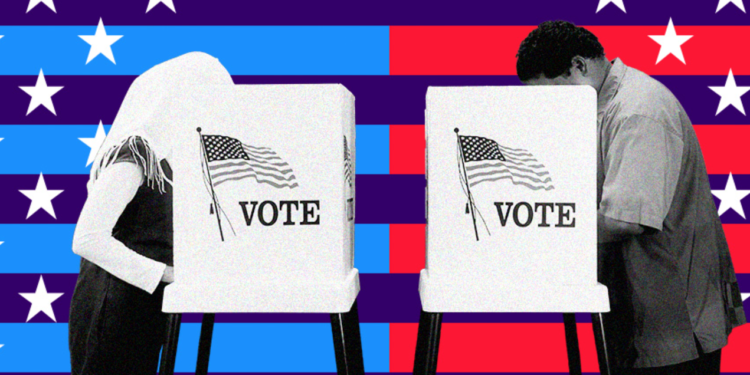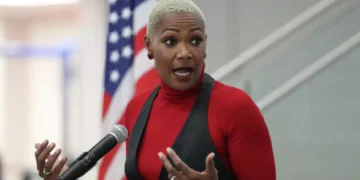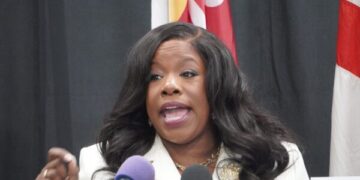Feb 18, 2025 Story by: Editor
In the November 2024 election, voters were nearly evenly split among three voting methods: 34% cast their ballots in person on Election Day, 32% voted early in person, and 35% utilized absentee or mail-in voting.
Election Day Voting
A third of voters (34%) reported voting on Election Day, a decrease from the 44% who did so in the 2022 midterms. However, this was a notable increase from 2020, when only 27% cast their votes on Election Day due to the coronavirus pandemic. Over the past two decades, the number of voters choosing to vote in person on Election Day has gradually declined, though this method remained the majority choice until 2018.
Early In-Person Voting
Early in-person voting saw a rise in 2024, with 32% of voters selecting this option. This marked an increase from 27% in 2020 and 21% in 2022, making it the highest level of early in-person voting recorded in recent elections.
Absentee and Mail-In Voting
The proportion of voters who cast their ballots via absentee or mail-in voting remained steady at 35%, mirroring the share from the 2022 midterms. However, this figure was notably lower than the 46% who voted by mail in the 2020 election.
Partisan Differences in Voting Methods
Voting preferences continued to reflect partisan differences. Republicans remained more inclined to vote in person on Election Day, while Democrats were more likely to vote by mail. However, early in-person voting gained popularity among both parties:
- 39% of Republican voters cast their votes in person on Election Day, compared to 28% of Democratic voters.
- 44% of Democratic voters voted by mail or absentee ballot, whereas 26% of Republican voters did the same.
- 35% of Republicans and 28% of Democrats reported voting early in person this year.
Voters Experiment with New Voting Methods
Most voters (87%) stuck with their usual voting method in 2024, while 13% opted for a new approach:
- 27% of early in-person voters were trying this method for the first time.
- 9% of absentee or mail-in voters reported using this method for the first time.
- 2% of Election Day in-person voters were voting this way for the first time.
Ease of Voting in 2024
A vast majority of voters (94%) described voting as an easy process in the 2024 election. Specifically, 79% said voting was very easy, and 15% considered it somewhat easy. Only 6% found voting somewhat (5%) or very (2%) difficult.
Both Donald Trump (95%) and Kamala Harris (93%) supporters reported similar levels of ease in voting, closely resembling voter sentiments from 2020, when 93% of Trump voters and 95% of Joe Biden voters found the process easy.
Wait Times for In-Person Voters
Most in-person voters had minimal wait times, with 72% reporting waiting less than 10 minutes, including 42% who had no wait at all. Meanwhile, 28% of in-person voters experienced waits of at least 10 minutes, with 11% waiting more than 30 minutes and 4% waiting over an hour.
Compared to 2020, wait times were shorter across various demographics:
- Race and Ethnicity: Black, White, Hispanic, and Asian voters reported similar wait times, unlike in 2020 when Black voters faced longer waits.
- Age: Both younger and older voters experienced similar wait times.
- Community Type: Urban and suburban voters encountered longer waits than rural voters, a trend consistent with past elections. Urban and suburban voters were about 10 percentage points more likely than rural voters to wait over 10 minutes.
- Voting Method: Early in-person voters faced slightly longer waits than Election Day voters—33% waited more than 10 minutes compared to 24% of Election Day voters.
- Candidate Preference: In-person voters for Trump and Harris reported similar wait times, whereas in 2020, Biden voters faced longer wait times than Trump voters.
Nonvoters’ Reflections on the Election
Among those eligible to vote but who abstained, 42% expressed regret for not voting, while 57% did not wish they had participated. These figures closely resemble previous elections, with 45% of nonvoters expressing regret in 2020 and 44% in 2016.
The reasons for not voting varied:
- 35% felt their vote would not make a difference.
- 31% cited a dislike of politics.
- 18% were unregistered or ineligible.
- 17% did not care about the outcome.
- 15% found voting inconvenient.
- 8% forgot to vote.
Looking Ahead: Evolving Voting Preferences
The 2024 election reaffirmed shifting voting trends, with early in-person voting reaching new heights and mail-in voting remaining a key option. As election policies continue to evolve, future voter participation rates and methods will likely reflect changing accessibility, convenience, and political engagement.
Source: Pew Research

















